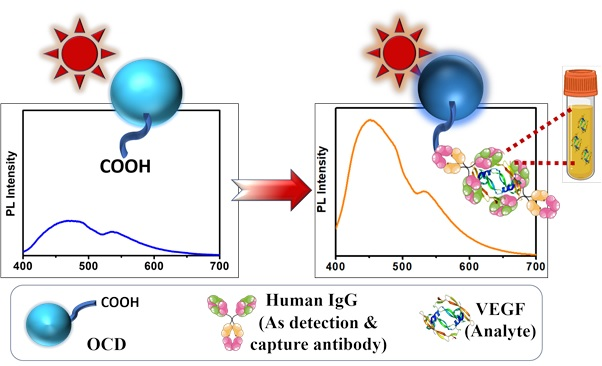An immunosensor developed with fluorescent nanomaterial can help detect the Vascular Endothelial Growth Factor (VEGF), a signalling protein that promotes the growth of new blood vessels and is considered cancerous if found in elevated levels in the blood.
VEGF is a factor that promotes angiogenesis or formation of new blood vessels, which involves migration, growth, and differentiation of endothelial cells that line the inside wall of blood vessels. It is upregulated in many tumors and hence gives indications of the probability of cancers. The dynamic interplay of nanotechnology and immunoassay has unlocked an arena for developing next-generation techniques for detecting such biomarkers, which can simplify the identification of cancer patients, especially breast cancer. Such technique will ensure rapid point-of-care testing for the early detection of cancer.

Institute of Advanced Study in Science and Technology (IASST), an autonomous institute under the Department of Science and Technology, researchers led by Prof. Devasish Chowdhury and his Ph.D. student Ankita Deb, fabricated an immunosensor based on the fluorescence phenomenon of biogenic carbon quantum dots, a new class of carbon nanomaterials, for the detection of the biomarker Vascular Endothelial Growth Factor (VEGF) which can lead to early detection of the disease.
The sandwiched immunosensor was fabricated using a fluorescent nanomaterial (Carbon quantum dots) synthesized from a natural source, employing a green microwave-assisted method. This was followed by conjugating with a detection antibody, human immunoglobulin G (IgG). The fluorescence immunosensor could detect VEGF in concentrations ranging from 0.1 fg/mL (fg=femtogram=10-15g ) to 10 pg/mL (pg= Picogram = 10-12g) with a low detection limit of 5.65 pg/mL towards VEGF. The potentiality of this designed immunosensor was qualitatively assessed with human blood plasma samples, showing the promising applicability of the fabricated system in immunoassay techniques. The work was recently published in the journal Analytica Chimica Acta.
Publication link






























